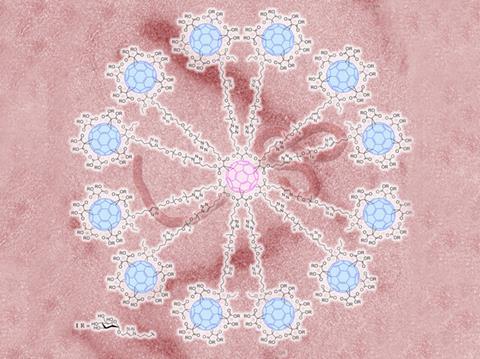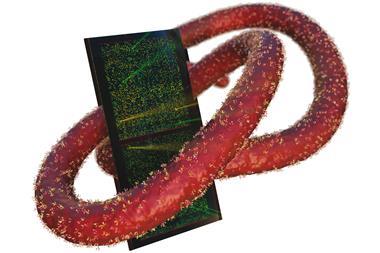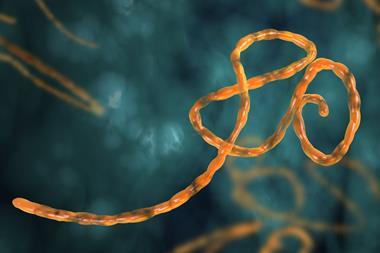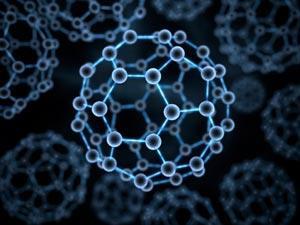Globular glycofullerene molecules prevent virus from evading immune system and entering cells

Molecular ‘superballs’ have been created that can stop viruses infecting cells. The molecules, which are based on C60 fullerenes, are water soluble and biocompatible, and have shown promise in vitro in preventing infection of cells by the Ebola virus.
Animals’ immune systems can be alerted to an attack by a virus when it binds glycoprotein receptors on the surface of some cells. This can provoke an immune reaction and prevent infection. However, certain viruses such as HIV and Ebola bind to the receptor and use it as a way to infiltrate the cell, circumventing the immune system.
It is possible to prevent the virus from slipping into a cell by filling the receptor with another molecule with greater affinity. Branched molecules, known as dendrimers, with sugars at the end of each branch have been used in the lab to bind to target receptors. However, large dendrimer synthesis is complex. Now a new type of molecule, using a three-dimensional carbon nanostructure as a scaffold, has been synthesised.
The ‘superballs’ are macromolecules composed of a core C60 fullerene unit, attached to a series of long chain molecules. At the end of each chain is another fullerene, with a shell of mannose carbohydrate units. The globular shape of these molecules mimics the shape of many types of virus, giving a good fit to the receptors. The molecules can be constructed in one pot using copper ‘click’ reactions, which reduces reaction time and gives excellent atom efficiency. The nature of the reaction means that it’s simple to substitute different sugars or biomolecules on the surface, allowing the superballs to be modified for many applications. Tests in vitro showed that the superballs were potent inhibitors of Ebola infection in sub-nanomolar concentrations.
Nazario Martín from the Complutense University of Madrid in Spain, part of an international team that carried out the research, says the superballs have great potential. ‘This is only the tip of the iceberg. The versatility of the molecule and the efficiency of the click chemistry make it very easy to modify the surface. We can use different sugars or biomolecules for different pathogens, or modify the number of carbohydrates decorating the surface – it will be quite possible to add 240 or 360.’
The superballs show great promise for use in medical treatments. ‘Not only Ebola virus, but also most infections are mediated by saccharide-protein interactions. Therefore the saccharides should be utilised more in development of medicine,’ says Yoshiko Miura, an expert in glycopolymer biomaterials from Kyushu University, Japan. ‘The key is multivalency to amplify the interactions. Using sugar– fullerene supramolecules is a unique and interesting approach.’
References
A Muñoz et al, Nat. Chem., 2015, DOI: 10.1038/nchem.2387












No comments yet